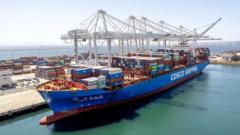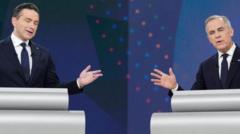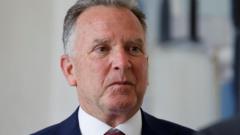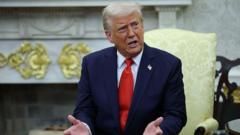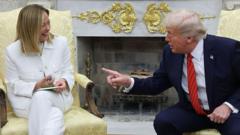President Trump's abrupt decision to pause tariffs has stirred significant reactions in various markets and across the global economic landscape.
Trump Temporarily Pauses Tariffs, Markets React Positively

Trump Temporarily Pauses Tariffs, Markets React Positively
In an unexpected policy shift, President Trump announces a temporary halt on tariffs, leading to a surge in market activity.
On April 10, 2025, President Trump halted his recently imposed steep tariffs on numerous trading partners in a surprising policy turnaround. His announcement indicated that a majority of the so-called reciprocal tariffs would be suspended for a 90-day period, also hinting at possible exemptions for some American companies. Currently, most U.S. trading partners are subject to a 10 percent blanket tariff, alongside hefty 25 percent tariffs on cars, steel, and aluminum products. Notably, China faces an escalated tariff of 125 percent—an increase from a previously proposed rate.
Market responses were overwhelmingly positive, with the S&P 500 witnessing a remarkable 9.5 percent increase—its largest single-day rise since 2008. The high tariffs had previously left economists voicing concerns about impending recession risks, but the recent policy shift prompted comebacks in financial markets, particularly in Asia where countries not impacted by tariffs saw significant gains.
While White House officials have characterized the tariff pause as a strategic move aimed at securing better trade agreements, Trump himself admitted that the reversal was largely a reaction to the turmoil observed in the markets, particularly the bond market. Steven Erlanger of The Times expressed uncertainty over Trump’s true motives, suggesting a complex relationship with tariffs and a desire to negotiate favorable terms with trading partners.
In related news, viewership for financial news channels has surged amidst the tariff discussions. Countries like Canada are bracing for financial impacts from retaliatory tariffs, while firms in the Philippines are spotting potential business chances arising from the evolving situation. Moreover, there are growing concerns among European luxury brands about the changes in trade dynamics.
As the implications of these tariffs continue to reverberate across the global economy, the focus remains on the evolving relationship between the U.S. and its trading partners, especially as the trade war unfolds.
Stay tuned as more updates unfold in this volatile economic climate.
Market responses were overwhelmingly positive, with the S&P 500 witnessing a remarkable 9.5 percent increase—its largest single-day rise since 2008. The high tariffs had previously left economists voicing concerns about impending recession risks, but the recent policy shift prompted comebacks in financial markets, particularly in Asia where countries not impacted by tariffs saw significant gains.
While White House officials have characterized the tariff pause as a strategic move aimed at securing better trade agreements, Trump himself admitted that the reversal was largely a reaction to the turmoil observed in the markets, particularly the bond market. Steven Erlanger of The Times expressed uncertainty over Trump’s true motives, suggesting a complex relationship with tariffs and a desire to negotiate favorable terms with trading partners.
In related news, viewership for financial news channels has surged amidst the tariff discussions. Countries like Canada are bracing for financial impacts from retaliatory tariffs, while firms in the Philippines are spotting potential business chances arising from the evolving situation. Moreover, there are growing concerns among European luxury brands about the changes in trade dynamics.
As the implications of these tariffs continue to reverberate across the global economy, the focus remains on the evolving relationship between the U.S. and its trading partners, especially as the trade war unfolds.
Stay tuned as more updates unfold in this volatile economic climate.

